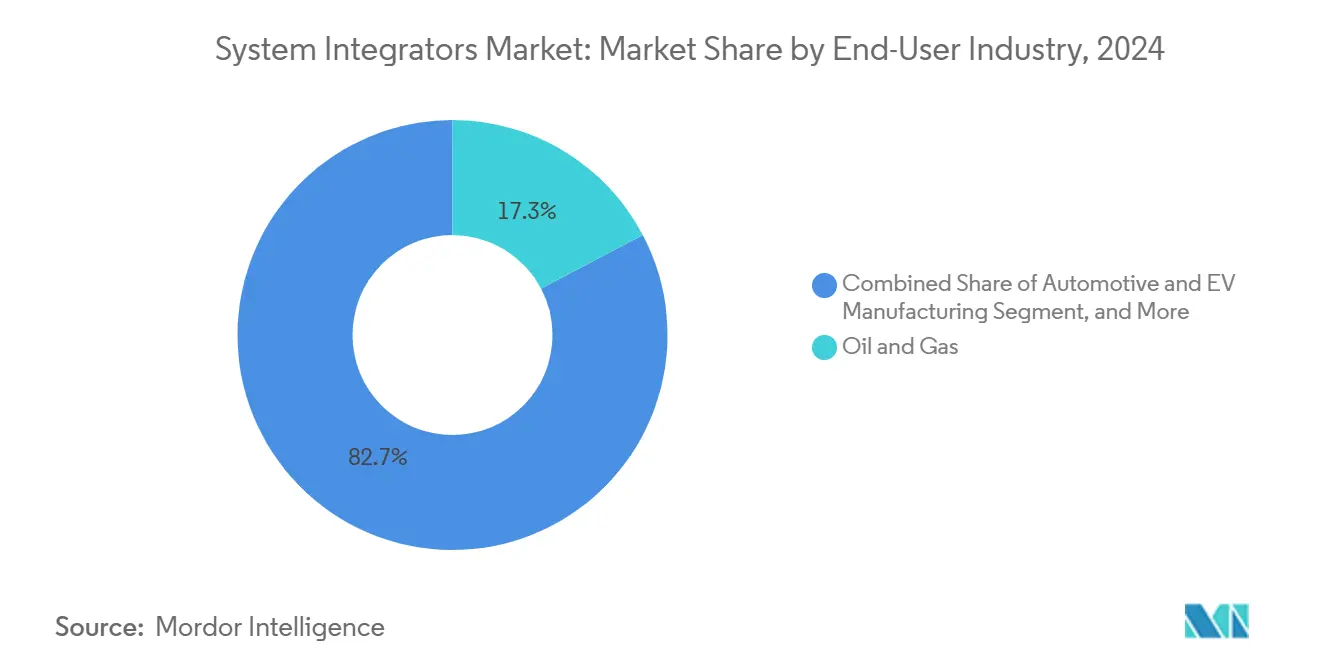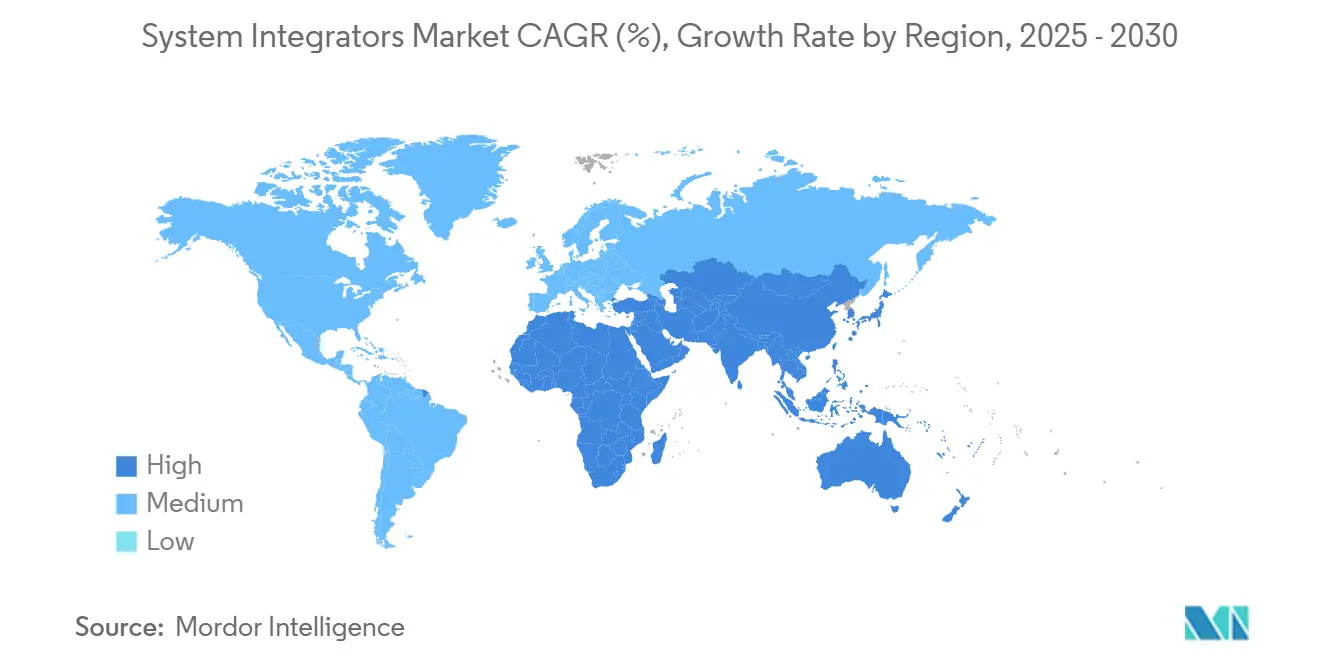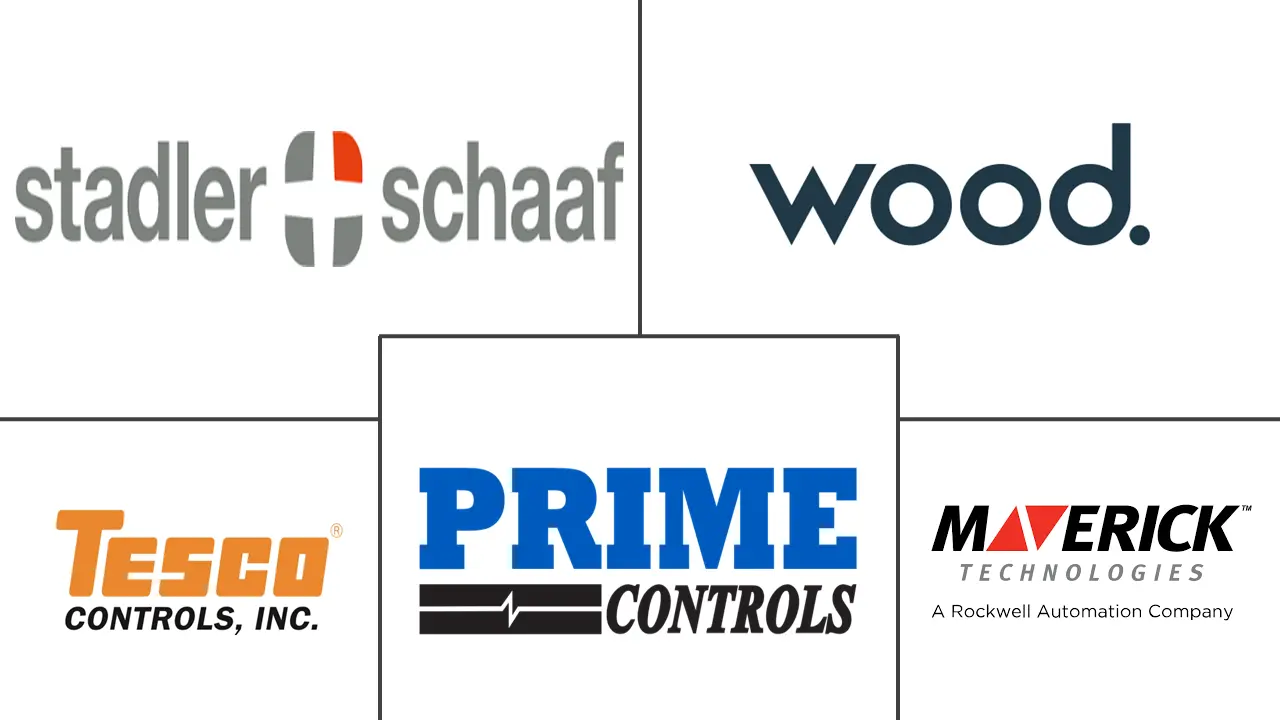System Integrators Market Size and Share

System Integrators Market Analysis by Mordor Intelligence
The global system integrators market size is valued at USD 46.91 billion in 2025 and is forecast to climb to USD 62.34 billion by 2030, advancing at a 5.85% CAGR. Expansion is underpinned by manufacturers shifting from isolated upgrades to turnkey OT-IT convergence projects that shorten payback periods while minimizing production downtime. Brownfield plants account for a rising share of new awards, and multi-vendor edge deployments anchored in private-5G are unlocking fresh demand for advanced orchestration skills. At the same time, utilities in Europe and Asia are digitizing renewable assets to comply with aggressive clean-energy targets, a change that favors integrators fluent in SCADA upgrades and DER management. [1]SolarPower Europe, “Mission Solar 2040,” solarpowereurope.org Regulatory cybersecurity mandates for critical infrastructure, most visibly in the Middle East, are widening the addressable pool of high-margin SCADA retrofit projects. [2]International Society of Automation, “Addressing SCADA Access Control Challenges,” isa.org Talent shortages on the plant floor further tilt the build-versus-buy calculus toward outsourcing, enabling mid-tier firms to capture share from large automation vendors.
Key Report Takeaways
- By service type, Software and Digital Integration held 48% of system integrators market share in 2024 while IIoT and Edge-Focused Integration is projected to grow at 9.2% CAGR to 2030.
- By technology, Integrated Process Control captured 34.5% revenue in 2024; Industrial Cyber-Security Solutions are advancing at a 10.4% CAGR through 2030.
- By end-user industry, Oil and Gas led with 17.3% revenue share in 2024, whereas Healthcare and Life Sciences is expanding at 8.7% CAGR over the same horizon.
- By enterprise scale, large enterprises contributed 71.2% of system integrators market size in 2024; small and medium enterprises are forecast to post a 7.9% CAGR to 2030.
- By region, Asia-Pacific commanded 31.6% revenue in 2024, while the Middle East is on track for the fastest 8.8% CAGR through 2030.
Global System Integrators Market Trends and Insights
Drivers Impact Analysis
| Driver | (~) % Impact on CAGR Forecast | Geographic Relevance | Impact Timeline |
|---|---|---|---|
| Turn-key OT-IT convergence in brownfield plants | +1.20% | North America and Europe core, global spill-over | Medium term (2-4 years) |
| Renewable-energy asset digitalization | +0.90% | Europe and Asia Pacific | Long term (≥ 4 years) |
| 5G-enabled edge computing projects | +0.70% | North America lead, APAC expansion | Short term (≤ 2 years) |
| Cyber-secure SCADA retrofits in critical infrastructure | +0.60% | Middle East and Africa, Asia Pacific spill-over | Medium term (2-4 years) |
| Modular automation adoption in biopharma CDMOs | +0.50% | North America and Europe | Long term (≥ 4 years) |
| Global shortage of automation talent | +0.80% | Global | Short term (≤ 2 years) |
| Source: Mordor Intelligence | |||
Demand for Turn-Key OT-IT Convergence Projects in Brownfield Manufacturing Plants
Turn-key OT-IT programs are replacing incremental upgrades because manufacturers now target ROI cycles below 18 months. The challenge of mapping decades-old PLCs to modern cloud architectures creates enduring demand for integrators able to manage coexistence, cybersecurity and analytics in one scope. Process industries feel this pressure most acutely, since one hour of unplanned downtime can exceed USD 50,000 in lost output. [3]Honeywell, “What OT/IT Convergence Means for Your Industrial Organization,” honeywell.com
Acceleration of Renewable-Energy Asset Digitalization Across Europe and Asia
European utilities must orchestrate nearly 900 GW of solar capacity by 2030, a milestone that compels tighter coupling of forecasting, storage and grid-balancing applications. [4]SolarPower Europe, “Mission Solar 2040,” solarpowereurope.org The BaxEnergy platform, now owned by Yokogawa, already monitors 120 GW of renewables across 40 countries, illustrating the scale and complexity of next-gen projects.
5G-Enabled Edge Computing Use-Cases Requiring Complex Multi-Vendor Integration in North America
Private 5G networks are proliferating across U.S. plants, yet most factories lack in-house teams that understand spectrum governance, URLLC protocols and industrial cybersecurity. Verizon’s 5G roll-out at a Cummins engine plant linked 1,500 employees, forklifts and machine-health sensors in a single network, a milestone delivered through specialist integrators that bridged C-band gateways and legacy PLCs.
Regulatory Push for Cyber-Secure SCADA Retrofits in Critical Infrastructure (Middle East)
Saudi Arabia’s Vision 2030 program sets fresh benchmarks for OT cyber resilience, exemplified by the USD 5 billion DataVolt AI factory at NEOM that bakes zero-trust architectures into its design. Legacy refineries and power stations across the Gulf now race to adopt similar frameworks, expanding the system integrators market as facility owners bundle security, networking and controls upgrades into single RFPs.
Restraints Impact Analysis
| Restraint | (~) % Impact on CAGR Forecast | Geographic Relevance | Impact Timeline |
|---|---|---|---|
| High project scope-creep risk | -0.80% | Global | Short term (≤ 2 years) |
| Semiconductor supply constraints | -0.60% | North America and Europe acute | Medium term (2-4 years) |
| Fragmented interoperability standards | -0.40% | Global | Long term (≥ 4 years) |
| Liability exposure from OT cyber incidents | -0.30% | Critical infrastructure sectors | Medium term (2-4 years) |
| Source: Mordor Intelligence | |||
High Project Scope-Creep Risk Elevating Total Cost of Ownership for End-Users
More than 40% of integration programs overshoot original budgets as engineers confront undocumented interfaces and obsolete firmware mid-project. The U.S. Government Accountability Office found that Category 1 technology projects still account for 81% of federal overruns, underscoring how scope drift persists even under strict governance.
Procurement Delays Caused by Semiconductor Supply Constraints
Lead times for certain industrial chips have stretched past 52 weeks, forcing redesigns and delayed commissioning. The United States may confront a 67,000-engineer shortfall by 2030 that will restrain fab capacity for high-end automation semiconductors. Firms often prepay for inventory, pressuring integrator cash flow and lengthening payback periods.
Segment Analysis
By Service Type: Software Integration Dominance
Software and Digital Integration controlled 48% of system integrators market size in 2024 on the strength of analytics, MES and cloud-edge orchestration suites. IIoT and Edge-Focused Integration posts a 9.2% CAGR to 2030 as firms deploy containerized workloads at the machine level. Hardware retrofits remain vital for brownfield sites, but their share is gradually receding as manufacturers monetize data rather than pure throughput. Consulting and Training demand is reviving because talent gaps force companies to upskill in-house staff, while After-Sales Support secures recurring revenue that cushions cyclical project flow. The Litmus Edge–Azure IoT tie-up typifies the pivot toward standardized connectors like OPC UA and MQTT that cut roll-out times.
A second structural change is the rise of proprietary integration platforms that bundle middleware, pre-built APIs and digital-twin libraries. These services allow integrators to monetize intellectual property beyond hourly engineering fees, increasing switching costs. As more manufacturers favor outcome-based contracts, software-heavy scopes will likely surpass 55% share of the system integrators market by decade-end.

Note: Segment shares of all individual segments available upon report purchase
By Technology: Process Control Leadership
Integrated Process Control solutions—PLC, DCS and SCADA—accounted for 34.5% of system integrators market share in 2024, evidence that foundational control layers still anchor digital transformation roadmaps. Even so, Industrial Cyber-Security Solutions outpace every other cluster at a 10.4% CAGR as ransomware moves from IT to OT domains. Manufacturing Execution Systems keep growing steadily because executives need unified production and business data to run profit-center accounting. Robotics and Machine Vision projects gain traction where labor costs outstrip capex depreciation curves.
Cybersecurity’s acceleration is visible in Rockwell’s acquisition of Verve Industrial Protection, which unified asset inventory, risk scoring and breach response in a vendor-neutral stack. Siemens echoed this trend with its SIBERprotect solution that triggers automated responses within milliseconds, balancing uptime and safety. As regulations tighten, integrators that embed zero-trust architectures into process-control migrations are set to capture premium fees.
By End-User Industry: Energy Sector Expansion
Oil and Gas held 17.3% of system integrators market share in 2024, underpinned by capital spending on methane-abatement and predictive-maintenance initiatives. Healthcare and Life Sciences is the fastest climber at 8.7% CAGR as CDMOs adopt modular automation to accelerate drug commercialization cycles. Automotive and EV manufacturers are uprooting combustion-engine lines to install battery‐pack, e-drive and final assembly modules that require multi-vendor orchestration. Aerospace and Defense spending also underpins demand for secure digital threads that trace parts from machine to mission.
Biopharma illustrates the rewards: Honeywell reports that module-type packages can cut greenfield plant build times by 40% while simplifying validation. Cytiva’s alliance with Cellular Origins fuses robotic handling with closed-loop analytics to scale cell-and-gene therapy output, a setup that only domain-savvy integrators can deliver.

By Enterprise Scale: Large Enterprise Focus
Large enterprises generated 71.2% of system integrators market size in 2024 because their global footprints demand standardized architectures, round-the-clock support and rigorous compliance audits. However, SMEs will expand at 7.9% CAGR through 2030 as cloud-native toolkits lower entry barriers. Siemens’ Opcenter X, optimized for SMB budgets, exemplifies how vendors tailor SaaS models that trim IT overhead and speed payback.
Standardization initiatives also help smaller firms. The OPC Foundation’s Cloud Initiative enlists AWS, Google and Microsoft to align data models, which slashes integration timelines and consulting spend. As these frameworks proliferate, SMEs will sign multi-year subscriptions rather than one-off projects, reshaping integrator revenue profiles toward annuity streams.
Geography Analysis
Asia-Pacific led the system integrators market with 31.6% revenue in 2024, spurred by China’s price-intensive automation landscape and India’s expanding ethanol and co-gen base. Local competitors such as Ditap-V Automatio win bids by balancing quality and aggressive pricing, raising pressure on multinational incumbents. Government-sponsored smart-manufacturing schemes amplify demand, yet geopolitical frictions and shipping bottlenecks threaten delivery schedules.
The Middle East is the fastest-growing territory, forecast at 8.8% CAGR through 2030. Vision 2030 megaprojects and an expanding regulatory net for OT cybersecurity elevate average project values. Emerson’s 140,000 ft² manufacturing hub at King Salman Energy Park shows how global vendors localize supply chains to satisfy in-country value quotas. Meanwhile, the India–Middle East–Europe Economic Corridor could slash freight costs by 30% once operational, creating further pull for integrators versed in cross-border standards.
North America and Europe remain lucrative but mature. The U.S. sees outsized growth from private-5G and edge-AI pilots, yet chronic labor shortages inflate wage bills. Europe’s renewable push forces utilities to blend grid-scale batteries, PV inverters and demand-response software in coherent stacks, an integration puzzle that sustains robust project pipelines. Both regions confront stringent safety codes that lengthen approval cycles, underscoring the value of domain-rich integrators.

Competitive Landscape
The system integrators market is moderately fragmented: no firm exceeds an 8% global revenue share, giving nimble specialists room to out-maneuver giants in niche applications. ABB, Siemens and Rockwell Automation leverage huge installed bases, but pure-play integrators counter with speed, vendor-agnostic toolkits and vertical depth. Consolidation is accelerating as incumbents acquire analytics, cybersecurity and cloud orchestration skills—ABB’s USD 150 million purchase of Siemens’ wiring-accessory unit in China broadens its smart-building reach.
Technology leadership now outweighs physical scale. The OPC Foundation’s multi-cloud blueprint may erode barriers associated with proprietary protocols, shifting rivalry toward outcome-based service models. White-space opportunities include quantum-safe encryption for OT, autonomous manufacturing cells and ESG-driven resource-optimization suites. Firms that convert pilot wins in these domains into repeatable reference architectures will capture durable premiums.
Strategic moves in 2025 highlight the pivot: Rockwell’s Emulate3D Factory Test integrates NVIDIA Omniverse APIs to virtualize acceptance testing, trimming on-site commissioning by weeks. NEOM’s construction-robotics venture with Samsung C&T proves how integrators expand beyond controls into autonomous construction systems, indicating an emerging frontier for margin growth.
System Integrators Industry Leaders
-
John Wood Group Plc
-
Prime Controls, LP
-
MAVERICK Technologies, LLC
-
TESCO CONTROLS, Inc.
-
STADLER + SCHAAF Mess- und Regeltechnik GmbH
- *Disclaimer: Major Players sorted in no particular order

Recent Industry Developments
- June 2025: Rockwell Automation debuted Emulate3D Factory Test within NVIDIA Omniverse to accelerate virtual controls testing and FAT.
- March 2025: ABB finalized its USD 150 million purchase of Siemens’ wiring-accessory unit in China.
- February 2025: NEOM and DataVolt agreed to build a USD 5 billion net-zero AI factory in Saudi Arabia.
- January 2025: Siemens was named leader in IDC MarketScape for MES 2024-2025 and launched Opcenter X for SMBs.
Global System Integrators Market Report Scope
System Integrators are the companies or individuals that implement, plan, coordinate, schedule, test, improve, and maintain a computing operation. System Integrators (SI) include companies that integrate systems such as Supervisory control and data acquisition (SCADA), Manufacturing Execution System (MES), and Human-Machine Interface (HMI), among others.
The system integrators market is segmented by service type (infrastructure integrators, software integrators), end-user industry (oil & gas, automotive, aerospace & defense, healthcare, power, chemical and petrochemical), and geography (North America, Europe, Asia Pacific, Rest of the World). The market sizes and forecasts are provided in terms of value (USD) for all the above segments.
| Hardware Integration |
| Software and Digital Integration |
| Consulting and Training |
| After-Sales Support and Maintenance |
| Integrated Process Control (PLC, DCS, SCADA) |
| Manufacturing Execution Systems (MES) |
| Robotics and Machine Vision |
| IIoT and Edge Platforms |
| Cyber-Security Solutions |
| Oil and Gas |
| Automotive and EV Manufacturing |
| Aerospace and Defense |
| Healthcare and Life Sciences |
| Energy and Power |
| Chemicals and Petrochemicals |
| Food and Beverage |
| Metals and Mining |
| Others (Water / Waste-Water, Pulp and Paper) |
| SMEs |
| Large Enterprises |
| North America | United States |
| Canada | |
| Latin America | Mexico |
| Brazil | |
| Argentina | |
| Rest of Latin America | |
| Europe | Germany |
| United Kingdom | |
| France | |
| Italy | |
| Spain | |
| Rest of Europe | |
| Middle East and Africa | |
| Asia-Pacific | China |
| Japan | |
| South Korea | |
| India | |
| Australia | |
| Rest of Asia Pacific |
| By Service Type | Hardware Integration | |
| Software and Digital Integration | ||
| Consulting and Training | ||
| After-Sales Support and Maintenance | ||
| By Technology | Integrated Process Control (PLC, DCS, SCADA) | |
| Manufacturing Execution Systems (MES) | ||
| Robotics and Machine Vision | ||
| IIoT and Edge Platforms | ||
| Cyber-Security Solutions | ||
| By End-User Industry | Oil and Gas | |
| Automotive and EV Manufacturing | ||
| Aerospace and Defense | ||
| Healthcare and Life Sciences | ||
| Energy and Power | ||
| Chemicals and Petrochemicals | ||
| Food and Beverage | ||
| Metals and Mining | ||
| Others (Water / Waste-Water, Pulp and Paper) | ||
| By Enterprise Scale | SMEs | |
| Large Enterprises | ||
| By Geography | North America | United States |
| Canada | ||
| Latin America | Mexico | |
| Brazil | ||
| Argentina | ||
| Rest of Latin America | ||
| Europe | Germany | |
| United Kingdom | ||
| France | ||
| Italy | ||
| Spain | ||
| Rest of Europe | ||
| Middle East and Africa | ||
| Asia-Pacific | China | |
| Japan | ||
| South Korea | ||
| India | ||
| Australia | ||
| Rest of Asia Pacific | ||
Key Questions Answered in the Report
What is the current value of the system integrators market?
The system integrators market is worth USD 46.91 billion in 2025.
How fast will the system integrators market grow through 2030?
Revenue is projected to increase at a 5.85% CAGR, reaching USD 62.34 billion by 2030.
Which service segment leads the system integrators market?
Software and Digital Integration services commanded 48% of 2024 revenue and remain the dominant segment moving forward.
Why is cybersecurity integration growing so quickly?
Regulatory mandates and escalating OT-focused threats are pushing Industrial Cyber-Security Solutions to a 10.4% CAGR through 2030.
Which region will expand the fastest?
The Middle East shows the highest forecast growth at an 8.8% CAGR, driven by Vision 2030 megaprojects and new cyber regulations.
How are talent shortages affecting the industry?
A lack of plant-floor automation expertise is prompting manufacturers to outsource full-scope projects, boosting demand for skilled integrators while extending delivery timelines.
Page last updated on:



